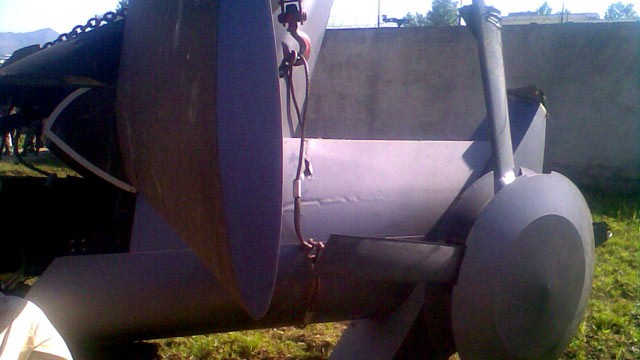Photographs taken after a Navy SEAL team raided Osama bin Laden?s compound in Pakistan show the wreckage of one helicopter that clipped a rotor on a compound wall, was abandoned and destroyed. (European PressPhoto Agency)
Pakistani officials said today they're interested in studying the remains of the U.S.'s secret stealth-modified helicopter abandoned during the Navy SEAL raid of Osama bin Laden's compound, and suggest the Chinese are as well.
The U.S. has already asked the Pakistanis for the helicopter wreckage back, but one Pakistani official told ABC News the Chinese were also "very interested" in seeing the remains. Another official said, "We might let them [the Chinese] take a look."
A U.S. official said he did not know if the Pakistanis had offered a peek to the Chinese, but said he would be "shocked" if the Chinese hadn't already been given access to the damaged aircraft.
The chopper, which aviation experts believe to be a highly classified modified version of a Blackhawk helicopter, clipped a wall during the operation that took down the al Qaeda leader, the White House said. The U.S. Navy SEALs that rode in on the bird attempted to destroy it after abandoning it on the ground, but a significant portion of the tail section survived the explosion. In the days after the raid, the tail section and other pieces of debris -- including a mysterious cloth-like covering that the local children found entertaining to play with -- were photographed being hauled away from the crash site by tractor.
Aviation experts said the unusual configuration of the rear rotor, the curious hub-cap like housing around it and the general shape of the bird are all clues the helicopter was highly modified to not only be quiet, but to have as small a radar signature as possible.
The helicopter's remains have apparently become another chip in a tense, high-stakes game of diplomacy between the U.S. and Pakistan following the U.S.'s unilateral military raid of bin Laden's compound in Abbottabad, Pakistan, more than a week ago. The potential technological advancements gleaned from the bird could be a "much appreciated gift" to the Chinese, according to former White House counterterrorism advisor and ABC News consultant Richard Clarke.
"Because Pakistan gets access to Chinese missile technology and other advanced systems, Islamabad is always looking for ways to give China something in return," Clarke said.
The Chinese and Pakistani governments are known to have a close relationship. Last month Punjab Chief Minister Muhammad Shahbaz Sharif concluded a trip to Beijing, afterwards telling Pakistan's local press that China was Pakistan's "best friend."
Dan Goure, a former Department of Defense official and vice president of the Lexington Institute, said last week the stealth chopper likely provided the SEALs an invaluable advantage in the moments before the shooting started.
"This is a first," he said. "You wouldn't know that it was coming right at you. And that's what's important, because these are coming in fast and low, and if they aren't sounding like they're coming right at you, you might not even react until it's too late... That was clearly part of the success."
Neighbors of bin Laden in Abbottabad, Pakistan, told ABC News they didn't hear the helicopters the night of the raid until they were overhead.
Officials at the U.S. Department of Defense declined to comment for this report, and a senior Pentagon official told ABC News last week the Department would "absolutely not" discuss anything relating to the downed chopper. Several Chinese government officials in the U.S. and in China were not available for comment.
U.S. officials have not officially disclosed any details on the helicopter, but President Obama said it was a "$60 million helicopter," according to a report by The Washington Post. While the price tag on normal Blackhawks varies depending the type, none cost more than $20 million according to the latest Department of Defense procurement report.




 12:13 PM
12:13 PM
 Humari news
Humari news





























